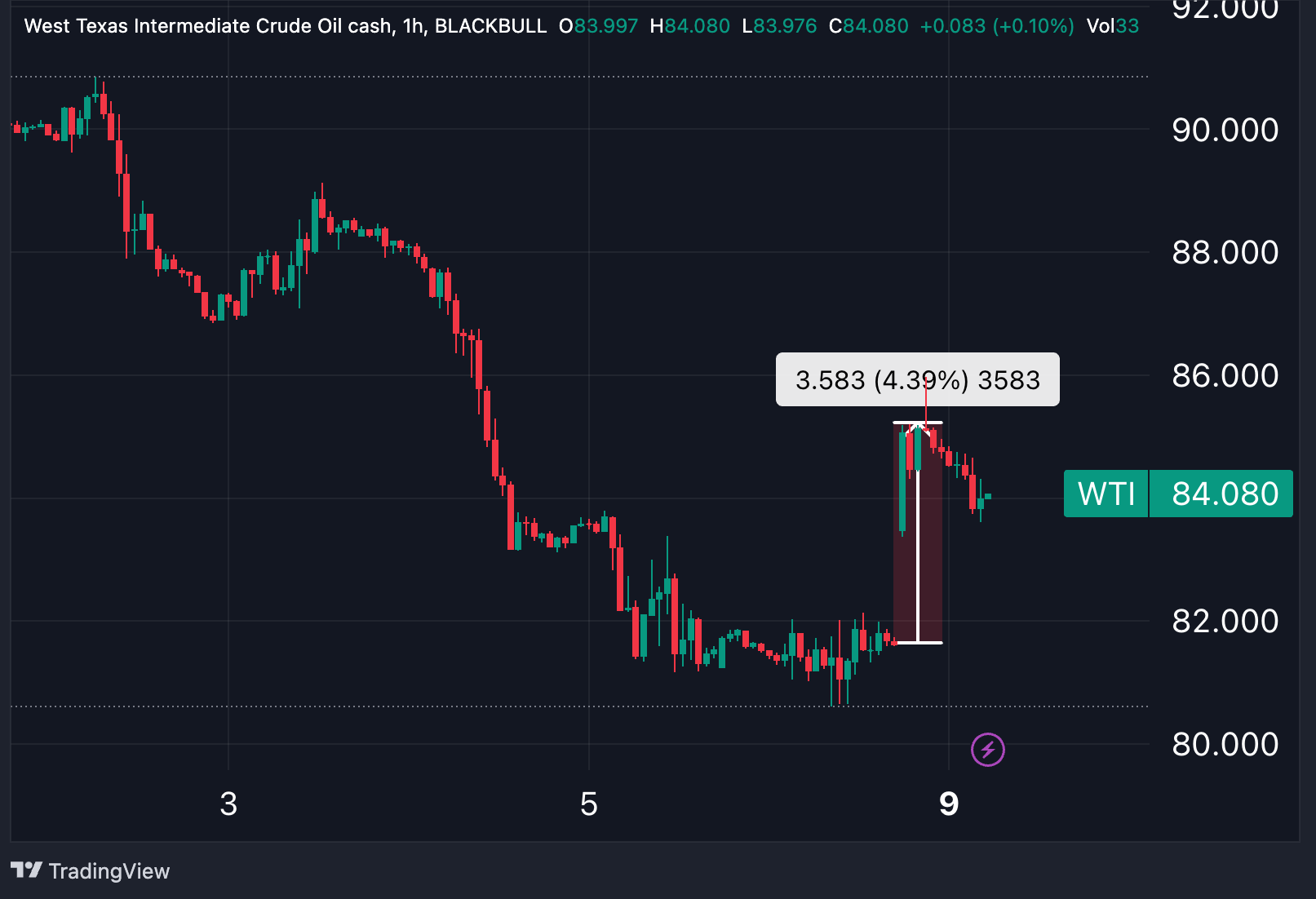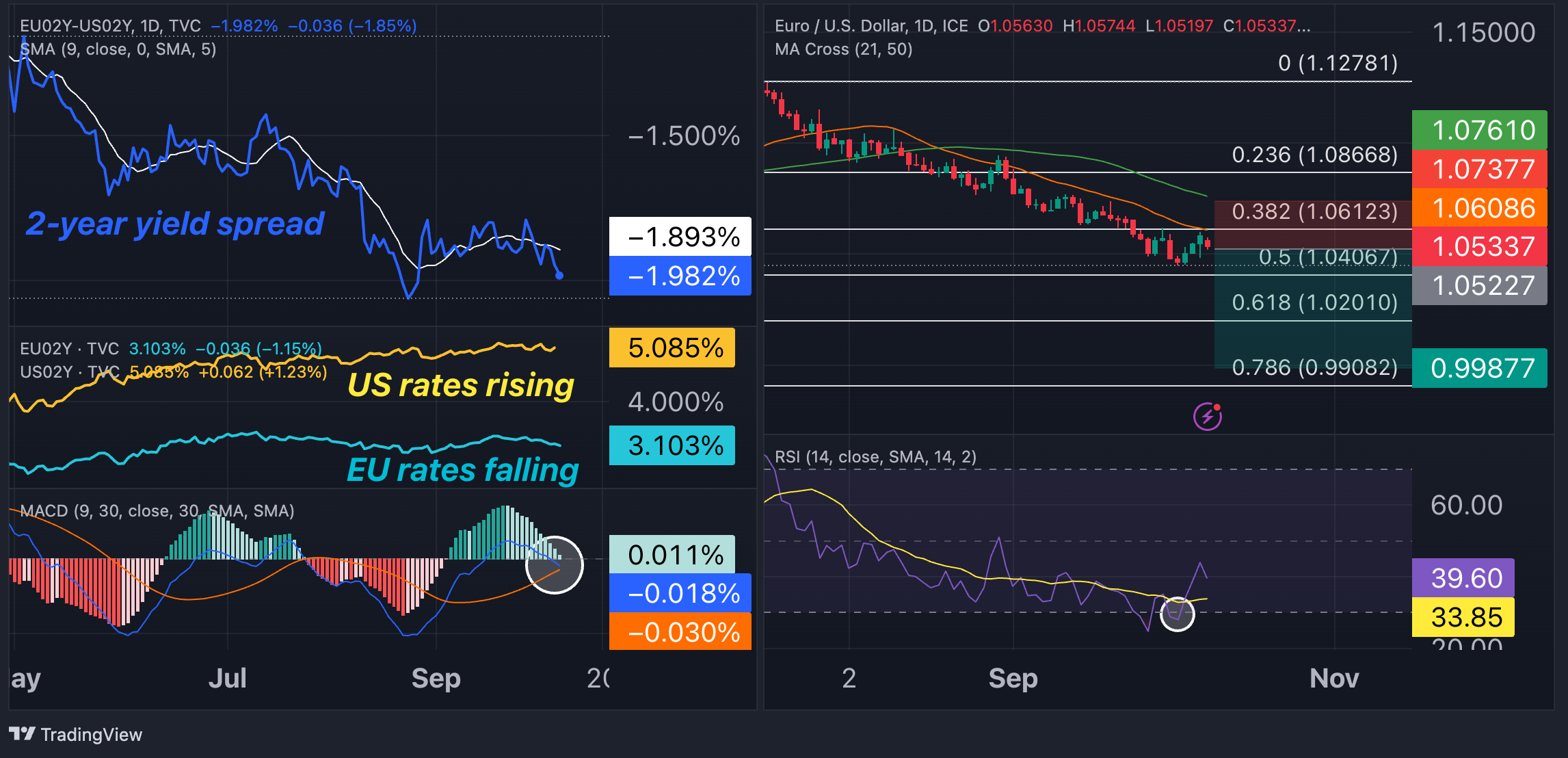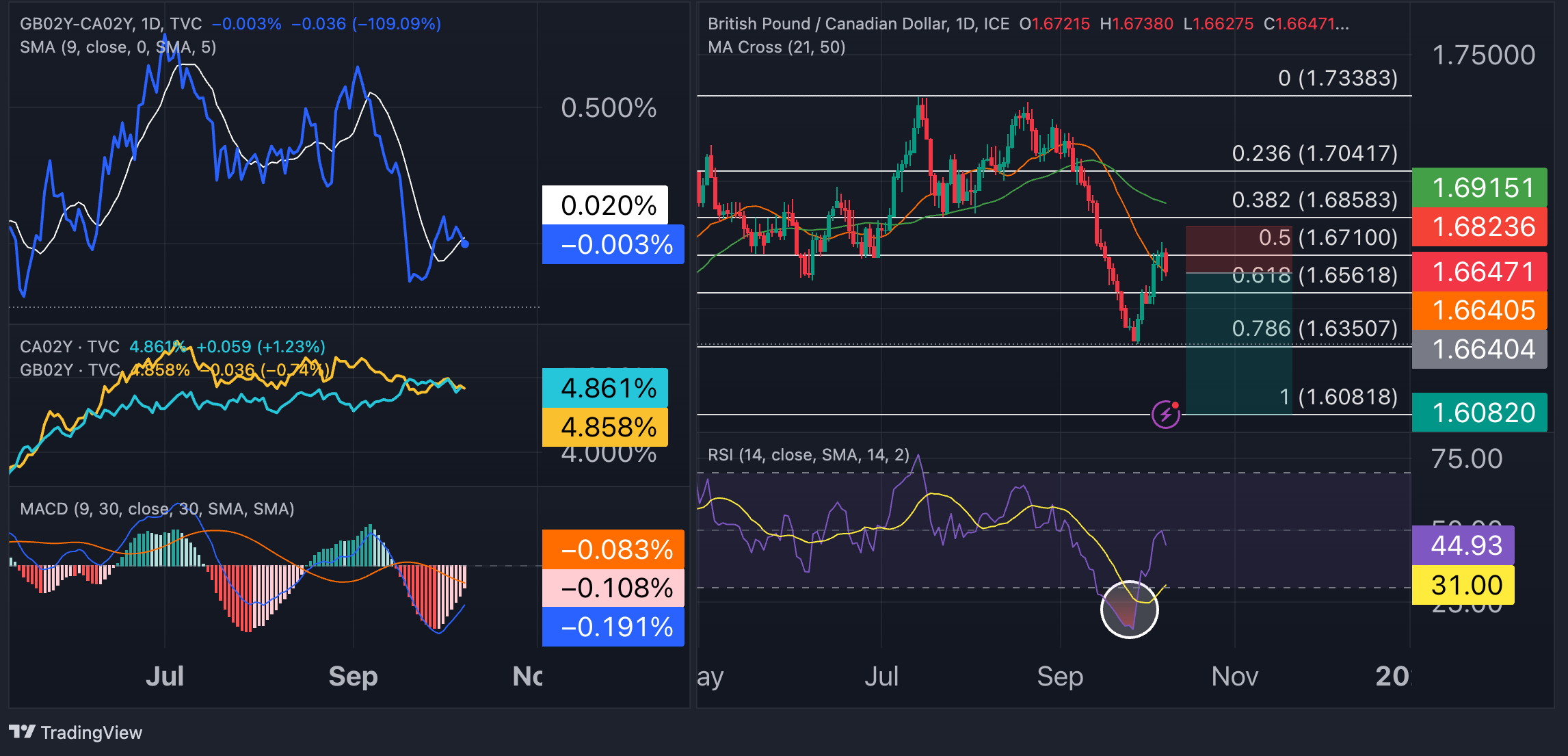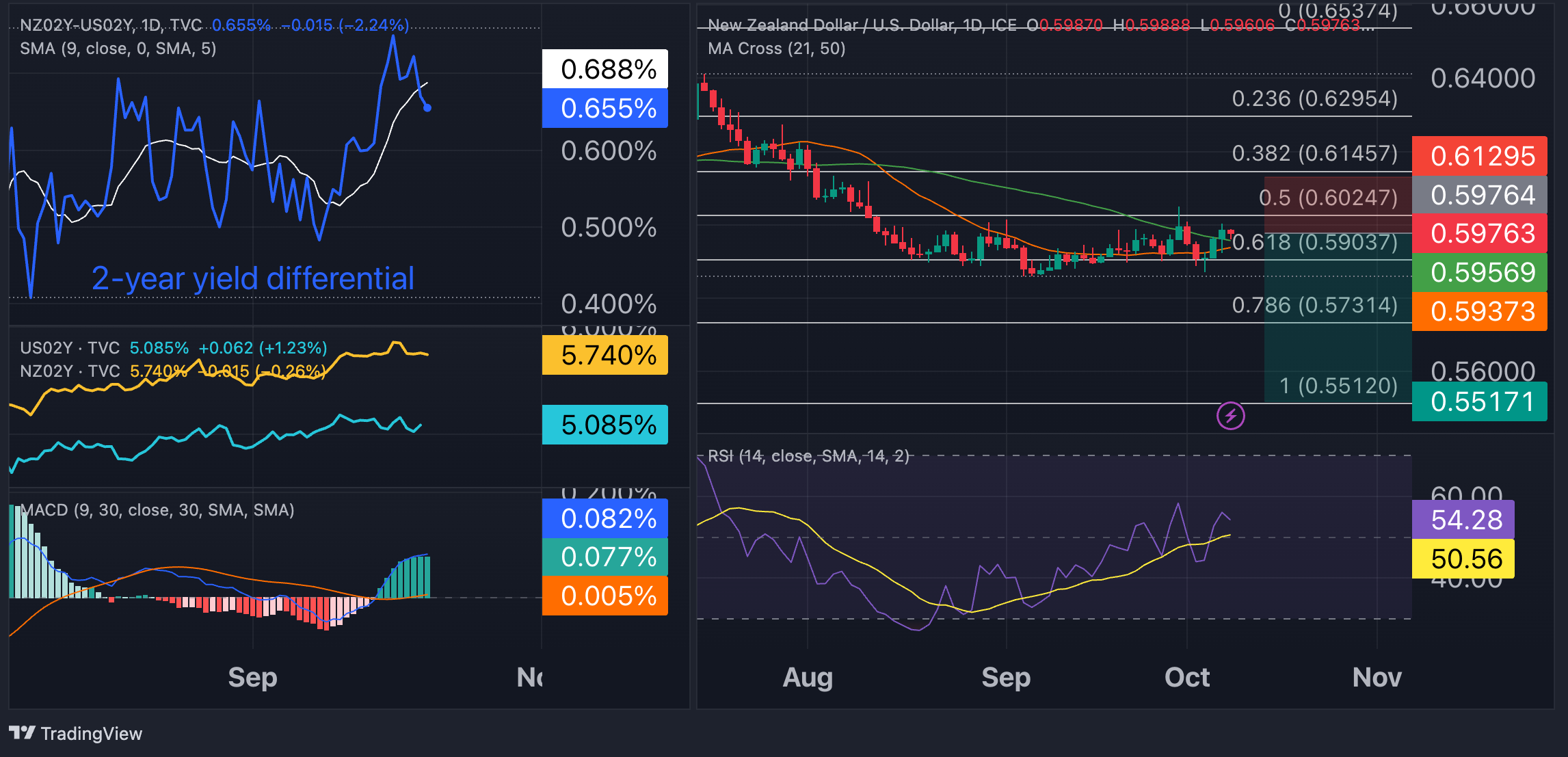Financial markets have awakened to a fresh wave of geopolitical turbulence, ignited by the ongoing conflict between Israel and Hamas militants. This development has raised concerns about the potential for further escalation and the resulting geopolitical and economic ramifications.
In a week that was already anticipated to bring substantial volatility due to the release of the September U.S. inflation report, the Israeli crisis and the oil rally have the potential to intensify the situation even further.
Forex Market Recap from the Previous Week
The U.S. dollar put an end to an eleven-week streak of gains, with the U.S. Dollar Index (DXY) closing the week slightly lower (-0.1%). Recent political developments in the United States saw Congress avoiding a government shutdown while simultaneously removing House Speaker Kevin McCarthy from his position. Concurrently, Treasury yields reached levels not seen in over 16 years, with the 10-year yield surpassing 4.80% and the 30-year yield spiking above 5%, driven by the sustained strength in the labor market. Non-farm payrolls surged to 337,000 in September, the highest figure since January, significantly surpassing expectations of 170,000. This development reignited the possibility of another Federal Reserve interest rate hike by year-end.
The Swiss franc (CHF) emerged as the top-performing currency of the week, appreciating by 0.6% against the U.S. dollar, despite Swiss inflation figures falling slightly below expectations (1.7% year-on-year versus 1.8%). Other currency gainers included the British pound (GBP), up 0.3%, and the euro (EUR), up 0.1%, as European currencies benefited from the decline in oil prices. Conversely, commodity-related currencies such as the Norwegian krone (NOK), the Australian dollar (AUD), and the Canadian dollar (CAD) lagged behind, depreciating by 2%, 0.8%, and 0.6%, respectively, against the USD.
Key Economic Highlights for the Upcoming Week
This week, it is crucial to closely monitor the U.S. Consumer Price Index (CPI) report, which will be the last key data point ahead of the FOMC meeting on November 1st. Expectations are for both the headline inflation rate to decrease from 3.7% year-on-year to 3.6% and the core inflation rate to decline from 4.3% to 4.1%. Additionally, the U.S. will release its Producer Price Index (PPI) inflation report, the Michigan Consumer Sentiment Index, and the minutes from the latest Federal Open Market Committee (FOMC) meeting. Throughout the week, influential central bank officials, including those from the Federal Reserve (Fed), the European Central Bank (ECB), and the Bank of England (BoE), will provide insights and make statements.
United States:
- Inflation rate (Thu.): 3.7% y/y previous, 3.6% expected.
- Core inflation rate (Thu.): 4.3% y/y previous, 4.1% expected.
- PPI (Wed.): 7% month-on-month previous, 0.3% m/m expected.
- Michigan consumer sentiment (Fri.):1 previous, 67.4 expected
- Fed speakers (-Fri.): Logan, Barr, Jefferson, Waller, Kashkari, Daly, Bowman, Bostic, Harker
Euro Area:
- ECB Monetary Policy Meeting Accounts (Thu.)
- Industrial production for August (Fri.): -1.1% previous, 0.1% expected
Other Data To Follow:
- Australia – Westpac Consumer Confidence (Mon.): -1.5% previous
- Norway – Inflation rate (Tue.): 8% previous, 3.8% expected
- Japan PPI (Wed.): 2% year-on-year previous, 2.3% expected
- UK GDP (Thu.): -0.5% month-on-month previous, 0.2% expected
Chart Of The Week: Middle East Turmoil Drives Spike In Oil Prices

New Trades for The Week
Short EUR/USD
- Entry: 1.0535
- Take profit: 1.000
- Stop Loss: 1.0750
- Risk/Reward Ratio: 2.5

EUR/USD Fundamental Analysis |
The Israeli crisis and the subsequent surge in oil prices are creating headwinds for import-dependent regions such as the Eurozone. Additionally, market risk-off sentiment and a rush to safe-haven assets are strengthening the dollar. The 2-year interest rate differential is once again widening, approaching -200 basis points. The high-quality 2-year euro yield is hovering around 3.10%, while the Treasury at the same maturity yields 5.08%. Should the upward trajectory of oil prices persist, the dollar is poised to receive further support, even if the CPI report meets or falls below expectations.
EUR/USD Technical Analysis |
Despite a modest rebound from oversold levels in the relative strength index (RSI), the EUR/USD trend remains bearish. The euro has been unable to close above the 21-day moving average for over a month. The next critical support level rests at 1.0406, coinciding with the midpoint between the 2023 highs (1.1278) and the 2022 lows (0.9532). A breach of this level would likely prompt further bearish momentum, targeting 1.0210 (61.8% Fibonacci retracement) and, subsequently, parity.
Short GBP/CAD
- Entry: 1.6646
- Take profit: 1.6082
- Stop Loss: 1.6823
- Risk/Reward Ratio: 2.9

GBP/CAD Fundamental Analysis |
Elevated oil prices provide a hedge for the Canadian dollar, which is expected to appreciate against commodity-dependent currencies such as the British pound. Yields on 2-year Canadian dollar bonds have now surpassed yields on 2-year British gilts. With the British pound's interest rate advantage effectively eroded, much of the focus in the GBP/CAD pair will depend on growth differentials. While the Canadian economy is expected to benefit from robust U.S. growth and a healthy labor market, the UK's outlook is showing signs of vulnerability, adding to GBP/CAD weakness.
GBP/CAD Technical Analysis |
The recent rebound in GBP/CAD was driven by extremely oversold RSI levels, but it has not reversed the overall bearish trend. Bulls encountered formidable resistance at the 50% Fibonacci level of the 2023 high-to-low range, reigniting bearish conviction. A retest of the September lows at 1.6351, which also aligns with the 78.6% Fibonacci retracement, could be in the cards in the upcoming weeks. Should bears successfully breach this level, they are likely to gain the upper hand in targeting the 2023 lows at 1.6082. A stop could be set above mid-September close at 1.6823.
Short USD/NZD
- Entry: 0.5975
- Take profit: 0.5512
- Stop Loss: 0.6130
- Risk/Reward Ratio: 3

NZD/USD Fundamental Analysis |
The resurgence of risk aversion among investors is a significant factor exerting pressure on the growth-sensitive New Zealand dollar (NZD). Although short-term interest rate differentials still offer a slight advantage to the NZD over the USD, this hedge may have peaked if the geopolitical crisis and rising oil prices lead to downward revisions in global growth forecasts, thereby pushing down short-term rates in the rest of the world. Keep a close watch on New Zealand's BusinessNZ Manufacturing PMI, scheduled for release this Thursday, as it could confirm a contraction in the sector, adding downward pressure on the Kiwi.
NZD/USD Technical Analysis |
NZD/USD has been stuck in a range-bound trading pattern between 0.5860 and 0.6050 over the past two months, but failing to breach above the 50% retracement level of the 2023 high-to-2022 low range. The recent breakout of the 50-day moving average and the RSI rebounding above 50 may provide false bullish signals. This is especially true given that overall market sentiment and fundamental factors could once again dominate the fate of this pair in the coming months. Looking at the medium term, bears may target the 2022 lows at 0.5512 as an attractive target, representing an 8% decline from current levels, should global risk-off sentiment intensify. A surge in the pair above 0.6130 would prove this bearish outlook wrong.
Open trading ideas:
- Short AUD/NZD
- Opened on October 2 at 1.0711
- Take Profit: 1.0470
- Stop Loss: 1.0793
- Profit & Loss: +0.6%
- Long CAD/CHF
- Opened on October 2 at 0.6702
- Take Profit: 0.6974
- Stop Loss: 0.6610
- Profit & Loss: -0.5%
- Long USD/JPY
- Opened on September 25th at 148.56
- Take Profit: 154
- Stop Loss: 147.20
- Profit & Loss: +0.4%
- Long USD/HUF
- Opened on September 25th at 366.97
- Take Profit: 383.60
- Stop Loss: 359.81
- Profit & Loss: +0.3%
- Short GBP/AUD
- Opened on September 18th at 1.9250
- Take Profit: 1.8600
- Stop Loss: 1.9560
- Profit & Loss: +0.5%
- Short CHF/JPY
- Opened on September 18th at 164.61
- Take Profit: 155.34
- Stop Loss: 167.00
- Profit & Loss: +0.5%
- Short GBP/JPY
- Opened on September 11th at 182.96
- Take Profit: 175.9
- Stop Loss: 185.6
- Profit & Loss: +0.7%
- Short EUR/JPY
- Opened on September 11th at 156.78
- Take Profit: 151.88
- Stop Loss: 158.5
- Profit & Loss: -0.3%
- Long USD/PLN:
- Opened on September 11th at 4.3058
- Take Profit: 4.6311
- Stop Loss: 4.1745
- Profit & Loss: +1%
- Short GBP/CHF
- Opened on September 4th at 1.1156
- Take Profit: 1.09
- Stop Loss: 1.1250
- Profit & Loss: +0.5%
- Short EUR/AUD
- Opened on September 4th at 1.6708
- Take Profit: 1.6200
- Stop Loss: 1.6900
- Profit & Loss: +0.8%
- Long USD/CHF
- Opened on August 28th at 0.8840
- Take Profit: 0.9250
- Stop Loss: 0.8680
- Profit & Loss: +3.1%
- Short NZD/CAD:
- Opened on July 24th at 0.8174
- Take Profit: 0.7975
- Stop Loss: 0.8263
- Profit & Loss: +0.1%




